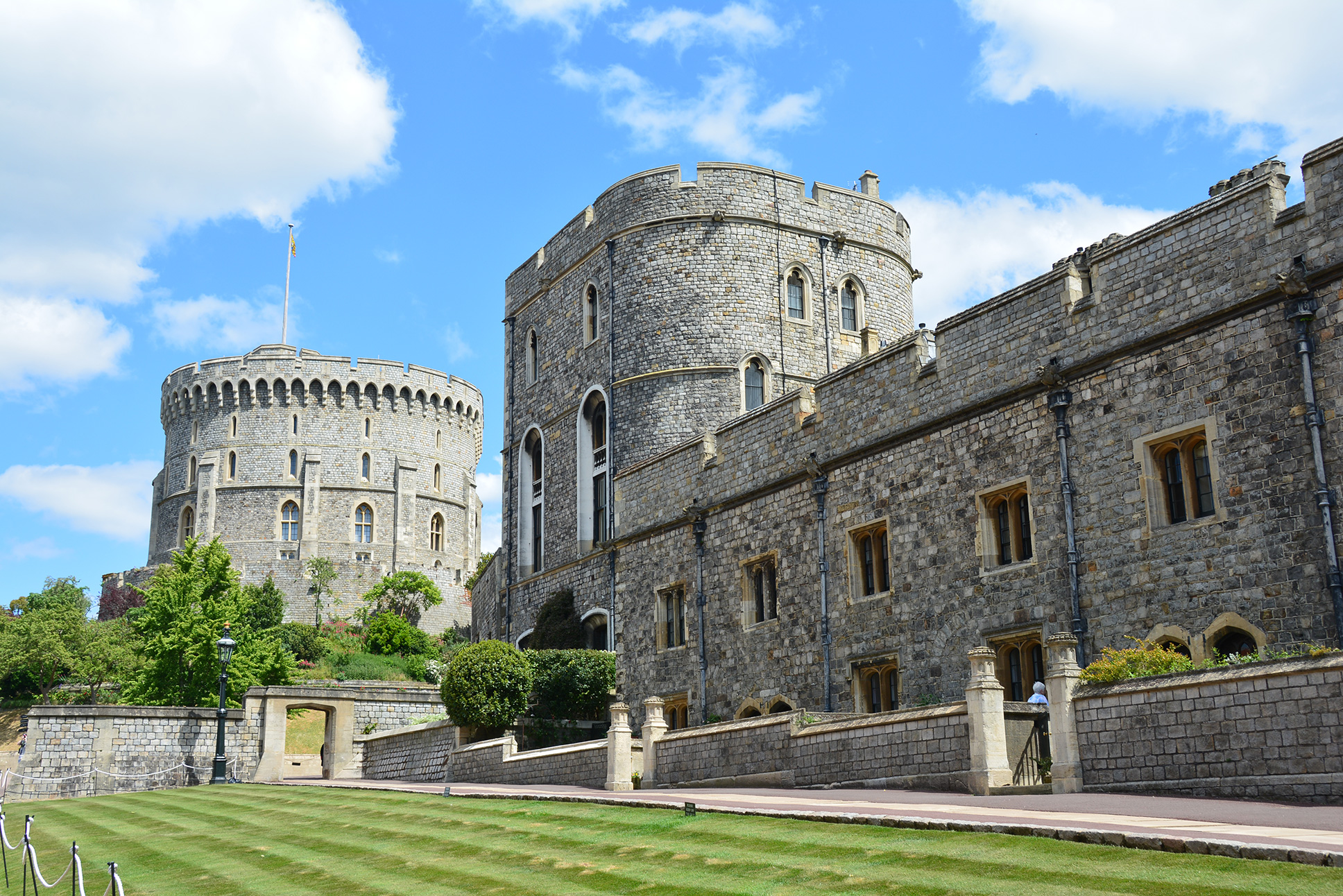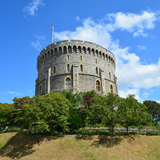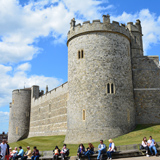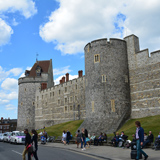History
Windsor Castle is the oldest and largest occupied castle in the world. It has been home to 40 English Monarchs. It was built to protect the western approach to London as part of a defensive ring of castles, each one a day's march from the city.

In around 1070, William the Conqueror chose to build Windsor Castle on the Banks of the River Thames, on the edge of a Saxon hunting ground. It took 16 years to complete the wooden motte and bailey fortress, and its closeness to a royal hunting forest made it an ideal location for a royal residence. Windsor Castle is rather rare in that it has a motte and two baileys, as is also the case at Arundel Castle.
By 1110, Henry I had domestic quarters within Windsor Castle. He was the first King to use the castle as a residence. His grandson, Henry II, converted the castle into a royal palace, building two sets of apartments within the castle. Henry II also began to replace the wooden walls and towers with stone. In 1170, the Norman keep was replaced with the Round Tower.
In 1214, Windsor Castle was besieged during the revolt of the English Barons. King John used the castle as his base during negotiations before the signing of the Magna Carta at nearby Runnymede in 1215. In 1216, the castle was besieged again by baronial and French troops, but the castle was successfully defended. Damage from the 1216 siege was immediately repaired and strengthened by 1221.
It would take 60 years to rebuild the castle in stone. Henry III rebuilt buildings in the Lower Ward, adding a new chapel with a cloister and courtyard.
Edward III was born at Windsor Castle, and between 1350 and 1377, he turned the castle into a gothic palace, spending over 50,000 pounds on the upgrades, which included an inner gatehouse with rounded towers leading to the Upper Ward and Royal Apartments with separate rooms for the King and his Queen, Phillipa of Hainault. Edward III also added St George's Chapel, which was enlarged in the late 15th century.
In 1357, Windsor Castle was used to hold French prisoners from the Battle of Poitiers, including John the Good (King John II of France), who was ransomed for 3 million crowns. In 1399, Henry IV seized the castle in an attempt to capture Richard II but failed as Richard had escaped to London.
Henry VI, known as Henry of Windsor, was born at Windsor Castle. He would become King at the age of nine months.
In the late 15th century, Henry Tudor (King Henry VII) added a narrow range west of the State Apartments. He would host a grand feast for the Order of the Garter at the castle soon after succeeding the throne. Edmund de la Pole, one of the surviving Yorkist Claimants to the throne, was imprisoned at Windsor Castle before being executed in 1513.
Henry VIII added a gate at the bottom of the Lower Ward, which bears his name, and a timber terrace along the north side of the Upper Ward where the King could watch the hunt in the park below. In 1536, during the Pilgrimage of Grace, Henry VIII used the castle as a secure base in Southern England to manage his military response to the uprising. The castle also served as a place to retreat to during outbreaks of plague in London.
In the 1570s, Elizabeth I took up residence at Windsor Castle and began extensive renovations. She also added a long gallery overlooking the North Terrace, which would later be incorporated into the Royal Library in the 19th century. Ten new brass cannons were also added for the castle's defense.
In 1642, in the aftermath of the Battle of Edgehill during the English Civil War, Windsor Castle was used as a military headquarters by Parliamentary forces and, in 1647, as a prison for Charles I. After his execution at Whitehall in 1649, his body was returned to Windsor Castle and interred in a vault beneath St George's Chapel, without ceremony.
In 1660, Charles II reclaimed the throne at the Restoration of the Monarchy and modernized the Royal Apartments into the grandest baroque State Apartments in England, boasting expensive textiles and tapestries.
George III updated several rooms in the Neoclassical style and added a Music Room and a new Dining Room in the East Range of the Upper Ward near the end of the 18th century. The Queen's Stairs were also replaced with the Grand Stair, which rose in long straight flights north of the Great Gate.
In 1820, after George IV was crowned King, he raised the height of the Round Tower and, reclothed the exterior in massive masonry and added battlements and towers. The Grand Stair was demolished to create the Inner Hall that gave an uninterrupted north-south view across the ground floor of the castle. The Waterloo Chamber was added, and St George's Hall was extended.
During Queen Victoria's reign, a new private chapel was created at the east end of St George's Hall. On December 14th, 1861, Prince Albert died at Windsor Castle. Victoria used the inner hall for almost 30 years, but in 1866, she had it closed off, and it was then used as a storeroom.
During World War I, anti-German feelings in England led the royal family to change their dynastic name in 1917 from the German "House of Saxe-Coburg and Gotha" to the "House of Windsor." King Edward III broadcast his abdication speech to the British Empire from Windsor Castle in December of 1936.
During World War II, King George VI used Windsor Castle as a refuge for the royal family from Luftwaffe bombing campaigns.
On November 20th, 1992, a fire broke out in Queen Victoria's private Chapel, which quickly spread, engulfing roof spaces and the ceiling of St George's Hall and the Grand Reception Room and destroying the Chapel, State Dining Room, and Crimson Drawing Room. A restoration committee led by the Duke of Edinburgh began restoration work, which resulted in St George's Hall being redesigned in a modern Gothic style and other damaged rooms restored to the same standard in which George IV had left them. The Holbein Room and old Private Chapel were destroyed in the fire and rebuilt in a harmonious new design. The restoration work was completed exactly 5 years after the fire.
In 2020, the Inner Hall was reopened, and a new route to the State Entrance Hall was completed.
Castle Highlights
Windsor Castle is a must-see for anyone who likes castles. It is also still home to the Royal family, so expect a wait to get through airport-like security if you visit. Also, expect the castle to be crowded with visitors as a major tourist attraction.
It is worth going through extra security and crowds. Some of the rooms are never open to the public as they are still in use. But enough is open to make it worthwhile.
The highlight of the castle is visiting the State Apartments in the Upper Ward, where you can see Queen Mary's Doll's House and the Grand Staircase, which displays knights on horseback flanking each side of the stairs, and medieval weapons and armor on the walls.
My favorite room at Windsor Castle, or any castle, is St George's Hall. Rebuilt after the fire, it occupies the site of Edward III's Great Hall. It has an enormous hammer-beam roof with suits of armor adorning the wall below every other beam. At one end of the hall is the King's Champion, another suit of armor on horseback. Dedicated to the Order of the Garter, the ceiling tiles display the coats of arms for the Knights of the Order of the Garter. The hall looks like something from a movie scene from the days of King Arthur.
In the Lower Ward, St George's Chapel is the final resting place of eleven sovereigns, including Henry VI, Henry VIII, Charles I, and Queen Elizabeth II. The Chapel is dedicated to the Knights of the Order of the Garter, whose banners hang below the vaulted ceiling of the choir. The Chapel is a fine example of Perpendicular Gothic architecture.
Windsor Castle can take a whole day to visit. The town of Windsor has many pubs just across the street from the castle to get some lunch or dinner and shops to buy souvenirs if you cannot find something in the few gift shops within the castle.
Windsor Castle is also haunted.


